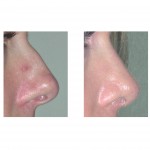
When a see an unhappy rhinoplasty patient (provided it is not my own), I always encourage them to return to their original plastic surgeon. It is not that I don’t want to see them but, on a practical level, working something out with the original surgeon is almost always better financially. No plastic surgeon wants an unhappy patient or an undesired result. So they will be the most motivated to work with you in getting closer to the result you want. Plus, some rhinoplasty results are not always indicative of the plastic surgeon’s skill or experience. The factors of nasal distortion caused by the healing process and scar contracture, or even infection, are surgical risks that happen to every plastic surgeon no matter how well executed the operation may have been.
Secondary rhinoplasty patients are usually different from primary or initial surgery patients. They often are much more skeptical and the emotional and cost issues of having surgery again can make them edgy and a little hostile. But because they are with a new plastic surgeon, they remain guardedly optimistic in most cases. I find that intense listening and see what bothers them is key, rather than envisioning how I would change it. Sometimes this can be a little difficult as it is not rare that the secondary rhinoplasty patient may not always be clear on exactly what bothers them. Without an exact list of identifiable areas on the nose that can be realistically changed, I will not engage in another surgical adventure. Second consults on revisional surgery are common and I encourage them. Third consults are probably a sign that this relationship should not proceed to the operating room.
The reality of certain nose problems after an initial rhinoplasty is that some corrections simply are not possible. Scar, lost anatomy, and the thickness of one’s nasal skin will limit what can be done the second time around. This does not mean that improvements can’t be made, just that perfection can not be achieved. The patient must be willing to settle for improvement as the main goal.
Common nose problems after a primary rhinoplasty which can be confidently improved are a residual bump or irregularity on the dorsum (bridge) of the nose, a scooped-out appearing nose (too much bridge lowering), middle vault collapse (pinched middle third of the nose with breathing difficulties), an overly narrowed or pinched tip, a supratip or pollybeak deformity (tip too full in side view without a supra tip break), and a hanging or retracted columella. (strip of skin between the nostrils) In most of these secondary problems, correction comes from adding tissue (cartilage) to provide support or more structure to the framework of the nose.
More difficult corrections include the residual crooked nose (no matter at what level the nose is not straight) and differences in the shape and size of the nostrils. These are more difficult to correct because the origin of the problem is multi-factorial and secondary scarring really works against what is achieved during surgery. This doesn’t mean that secondary rhinoplasty surgery should not be done but expectations have to be tempered.
As an Indianapolis rhinoplasty surgeon, secondary nose surgery correction can be complicated by scarring and anatomical loss of tissue as well as the emotional state of the patient. Good communication and realistic expectations are the key to determining whether further surgery is of merit for both patient and plastic surgeon.
Dr. Barry Eppley
Indianapolis, Indiana


